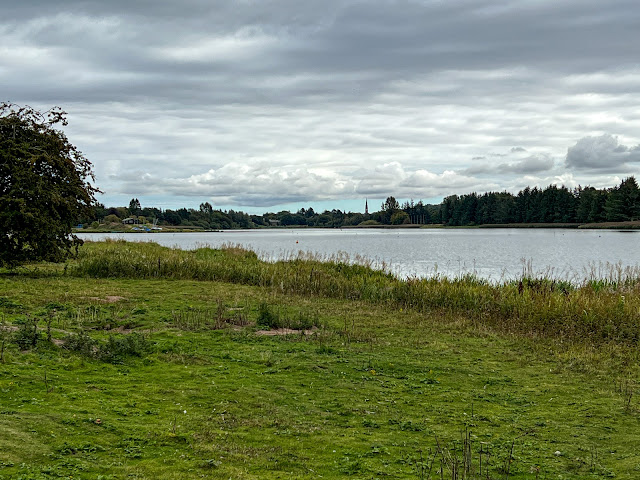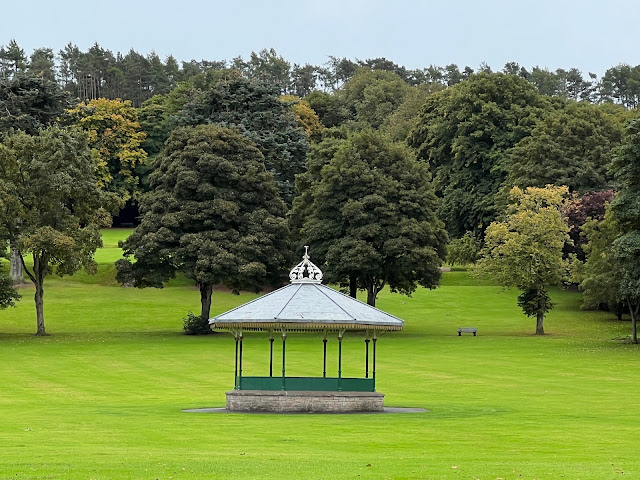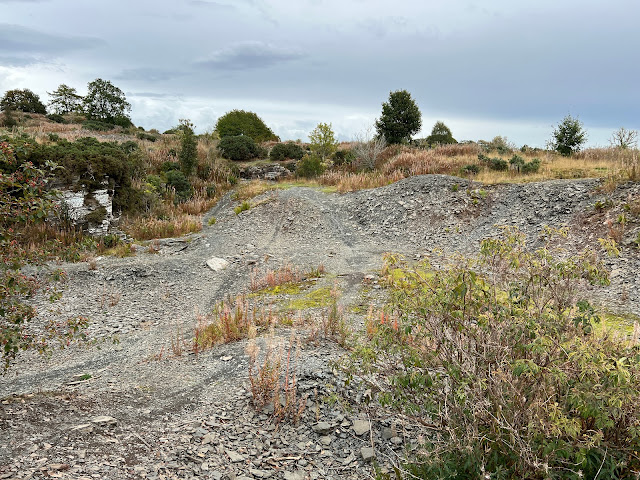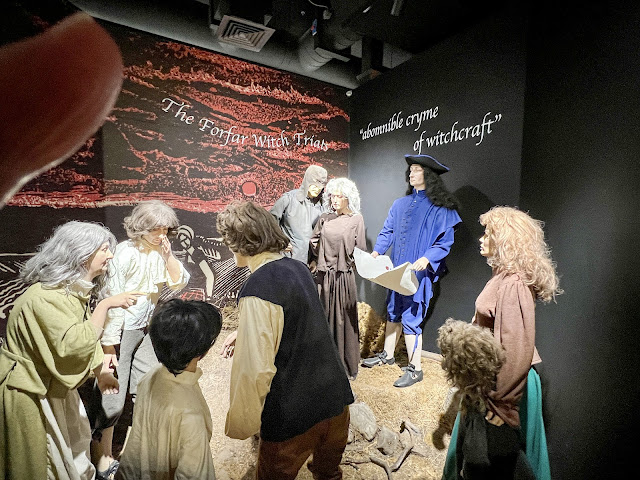Forfar lies in the heart of Angus, surrounded by the rich farmland of Strathmore. One thousand years ago Strathmore was an inhospitable area of bog, lochs and scrub, and Forfar was one of the few crossing points. It was an important residence of Scottish Kings, with a royal castle on the shores of Forfar Loch. It became a Royal Burgh in the 12th century but remained a small town until the 17th and 18th centuries, when farming expanded and huge quantities of flax were produced. Osnaburg cloth from local mills was exported to America and West Indies to cloth slaves. Today it's the administrative centre of Angus and livestock market town and is a very busy wee place with lots of general shops, restaurants, take-a-ways and a lot of supermarkets both in and on the outskirts of what’s become a bustling wee centre.
The Forfar Lochside Club Campsite we stayed at is a short walking distance from the town and edges the Forfar Loch. Its amenities are what you would expect from a Caravan and Motorhome Club site, well organised, large pitches surrounding a large central grassed area with ample toilets and showers which were kept very clean. As usual you can't trust people to keep them that way!
Our first outing was a 3 mile circular walk around Forfar Loch on mainly hard surfaced paths. Before the Earl of Strathmore, who owned the Loch originally, drained part of the loch it extended right into town. A short way into the walk you will come across a community orchard from which you are allowed to pick apples as long as you don’t take too many.
Towards the end of the walk is a memorial stone to the Forfar Witches erected in 2020.
One of the main reasons for staying in Forfar is its close proximity too Dundee and the V&A Museum which we had only seen some years ago in the building stage. The outside and inside design are certainly unique.
There seems to be a lot of wasted space internally with a large shop and picnic area taking up most of the space on the ground floor.
Two exhibitions were on. Firstly, i suppose as this is Scotlands design museum it had a large area on the upper floor designated as Scottish Design Galleries.
“Explore the everyday relevance of design and how it improves our lives, experience the processes that underpin it and discover little-known stories of Scottish design with international impact.
Ranging from architecture to fashion, healthcare to furniture, and engineering to video game design, around 300 exhibits have been drawn from the V&A’s world-famous collections of art, design and performance, as well as museums, private collections and designers across Scotland and the world.”
Actually to be honest we did not really enjoy this exhibition as we found it to be disjointed. But the second exhibition was much more to our liking.
Telling quite a human story Sincerely, Valentines – From Postcards to Greetings was told through the eyes of the folk that actually worked there. It told the story of Scotland’s most pioneering and successful commercial photographers, best known for popularising the holiday postcard on a global scale.
Founded in 1825 in Dundee, Valentines capitalised on rapid developments in photography, printing and tourism in the early 20th century to create a fascinating body of work and a vibrant industry, quickly becoming one of Dundee’s largest employers.
Developed in collaboration with University of St Andrews and curatorial practice Panel, the exhibition features rare photographs, historic postcards, promotional company magazines, booklets and greetings cards from the James Valentine photographic collection and private lenders including former employees of the firm.
Central to the exhibition is new work from designer Maeve Redmond who has created a series of oversized postcards in response to the vast Valentines archive print collection, and a new film by Rob Kennedy focusing on the stories and experiences of those who worked for Valentines, highlighting the important contribution Valentines made to Dundee’s social, cultural and industrial heritage.
The bus back to Forfar was delayed due to driver shortage but still a worthwhile trip into Dundee Scotlands only UNESCO City of Design.
A really enjoyable walk was up Balmashanner Hill which dominates the skyline south of Forfar it includes a network of paths linking the old slat quarries on the hill. An energetic 3/4 mile walk with some grand views across the town. But it is made far more interesting by some of the things you come across during the walk.
The bandstand was erected in 1900 and the park was a meeting place for the workers from the six mills which existed in Forfar at the time.
The statue is of Peter Reid, confectioner and ex-provost who gifted park (along with Reid Hall) to the people of Forfar.
On leaving the park you come across the a large war memorial at the top of the hill. Designed by by architect Thomas Robert Souter it was built in 1921 by Alexander Adamson Jr with joinery work by David Stewart. It was built to commemorate the towns servicemen who died in the First World War. It is from this vantage point that you gain a wonderful panoramic view of the Strathmore Valley.
Keep going passed the monument and you will go through the quarries, where many of the slates of Forfar’s houses came from, before descending down to Dundee Road and back into town.
A 125 bus from the town will take you directly into the large picturesque grounds of Glemis Castle which has been the ancestral seat to the Earls of Strathmore and Kinghorne since King Robert II granted the Thanage of Glamis to Sir John Lyon in 1372. Once host to Mary Queen of Scots (she certainly stayed in a lot of places) Glamis is said to have inspired one of Shakespeares most famous plays, Macbeth. Glamis also has a deep connection to todays Royal Family as it was the childhood home of the late Queen Elizabeth the queen mother and birthplace of HRH Princess Margaret.
The family still live in part of the castle and we do not get to see a large part of it or its gardens . But all in all an interesting day out made better by the weather and a door to door service by local transport. The bus driver told us he works a 12 hour day, 6 days a week with very little break time. sounds like slave labour to me!
ANGUSalive Meffan Museum and Art Gallery situated in Forfar Town Centre was originally funded by a legacy of £5000, left by Miss Jane Meffan in memory of her father, the former Provost William Meffan, and was to contain a Reading Room, Free Library, Reference Room, a Museum and a Hall. In 1988 the library moved further along West High Street. Today the Museum tells the story of Forfar from stone Age right through to the last days of the Royal Burgh. On display are Pictish Stones along with the reconstructed Vennal with its trades and crafts.
Forfar Witch Trails are also depicted as Forfar is framed for its witches who apparently danced on graves and frolicked (lovely word) with the devil, only to be imprisoned in the towns jails and burnt to death in a barrel of tar.
We enjoyed our stay and would not hesitate to recommend it to others. I think we may certainly return at some stage.



































No comments:
Post a Comment